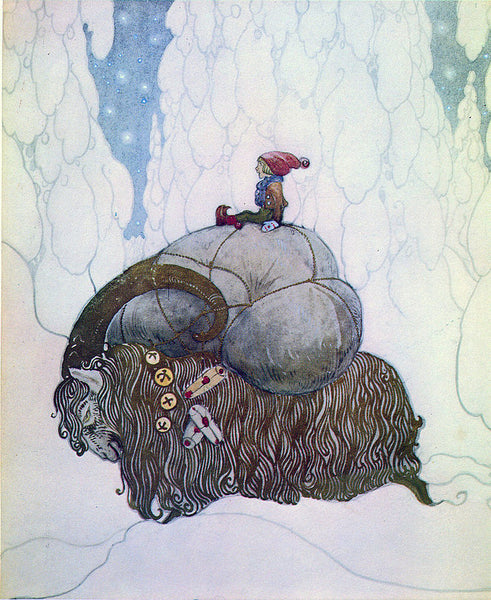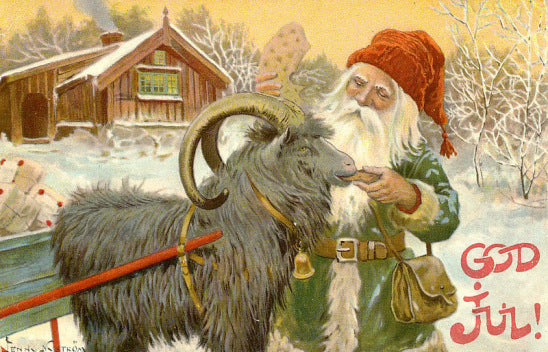
Our first guest blogger is Ewa Nienartowicz, historian and archivist with a total focus on different art experiences. Feel free to read more about Ewa on her own blog Art level.
What we stick to is Ewa´'s way of presenting and writing about art "Art is Life" and her instagram account is well worth following. A very good start to the day on a cloudy winter day.
John Bauer, among elves and trolls by Ewa Nienartowicz / Konspegel.
Scandinavia has its own, beautiful Christmas traditions. The word "Christmas" occurs from the Old English yule, which is probably the common heritage from the Viking housing times.
History, myth and traditions characterize the Christmas season and gather us all at the table, but we must not forget the old times.
Swedish folklore is based on the belief that there are creatures that live in the corner of the native landscape. The dense forests in Småland hide mischievous elves, ugly trolls, evil witches and tempting nymphs.

John Bauer "Julbocken" (1912) Watercolor, gold color, off-white and pencil on paper 34.5 x 29 cm Bukowskis.
Stories that stimulate the imagination of both children and adults were re-written in the early 20th century, and their enormous popularity was mainly influenced by beautiful illustrations that complemented the book editions.

One of the most famous artists was John Bauer and Konstpegeln wants to make a journey through time, to the deepest memory of childhood! Is there a better time than Christmas?
Culture and nature.John Bauer was born in 1882 in Jönköping and grew up in the Småland area. Mother was Swedish, father was from Germany. He made a lot of money in business, first in Gothenburg and then in Jönköping. So John and his siblings were brought up in good conditions, and when the future artist decided to devote his life to art, his parents did not try to interrupt his plans.
As a 16-year-old, John moved to Stockholm to study art at the Technical School (now Konstfack). After two years of education, he was accepted as a student at it Royal Academy of Fine Arts, and began his studies during the autumn semester of 1900.

John spent his free time exploring collections from the capital's museums and libraries, where he sketched various historical themes, such as medieval costumes presented at the Nordic Museum.
As a student he was not very diligent and industrious, but all the professors praised him for the careful and thoughtful application of the line.
This means that John Bauer's future lies in illustrations!
During his summer vacation in Jönköping, Bauer went out into nature all day and worked intensively with drawings of flowers and herbs. Already in work from 1901 you can see different plant motifs; the watercolor-colored studies of flowers, which “The dandelions”(1901, Jönköping County Museum), is far from botanical sketches. Nature was a very important part of Bauer's work.
A trip to Lapland (1904)At the beginning of the 20th century, they searched for parts of the Swedish national identity, important historical events as well as folk traditions. An important place in this process was the recently "discovered" Lapland, the northernmost part of the country inhabited by the Sami, a people exotic to the Swedes from the south. By using their own language, with different customs and beliefs, the Sami became the subject of interest for ethnologists, anthropologists and artists.
John Bauer began a month-long trip to Lapland in the summer of 1904 and, together with several other artists and photographers, documented the everyday life of the Sami people. He outlined nature, unknown to him before, including above all the harsh, almost treeless landscapes and the exotic behavior and costume of the Sami. When he returned, he made a series of watercolors, 11 of which appeared in a collective book summarizing the expedition "Lapland: The Great Swedish Future Land - A description in words and image of its nature and people" (1904). Details often recur in Bauer's fairy tale illustrations.
”Among elves and trolls”
The Sami experience has provided many new inspirations. Sami fur suit, the reindeer skins became an integral part of the troll's garments, whose performances gave Bauer the greatest fame. The illustrations for "Among elves and trollsl ”was an addition to stories by Swedish authors, incl. Helena Nyblom, Cyrus Granér and Elsa Beskow.
Story collection was founded by the newspaper man Erik Åkerlund (1877-1940) and has been published annually at Christmas time since 1907. John Bauer illustrated "Among elves and trolls" between 1907-1910 and 1912-1915. Pictures for the book was a big breakthrough and a good period began in John Bauer's life. In December 1906 he married Esther Ellqvist, a friend from studies. In many paintings he depicts his wife: "The Fairytale Princess" has a lot of pre-Raphaelite spirit!
We recommend you read the entire blog post about John Bauer and also get to see more of his fantastic illustrations that Ewa picked out in her blog post.
Many thanks Ewa and Konspegel for wanting to be part of our Guest Blog❣️
In conclusion, we have chosen some illustrations that we associate with our childhood Christmases and fairy tale moments. At our Digital Christmas Market on December 13, we will have with us the book Santas and Trolls illustrated by John Bauer, which our mother read aloud to us.





